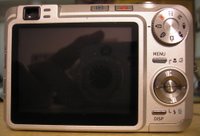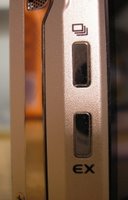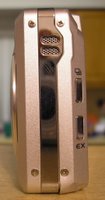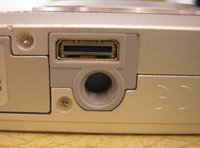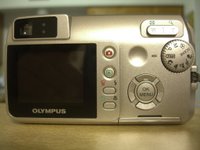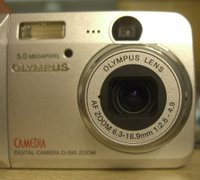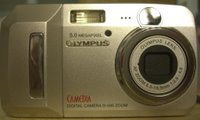I suppose, if I am going to look for the ideal low cost digital camera/video camera I should know what I am looking for, so I thought I would describe some of the attributes I want in a camera, to help clarify for you where I am coming from. So, here is a list, in no particular order;
Resolution: More is better, but not too high, because it will take too long to save the images on the flash card. Since most of these cameras have only digital zoom, 3MP is pretty much the minimum acceptable pixel count, because the pictures almost always need to cropped. More than 5 MP or 6 MP will likely result in the camera taking too long to save the images, and slowing down the rate at which pictures can be taken.
Size: the camera should be small enough to fit into a pocket, and should ideally provide protection for the lens and LCD screen. Most cameras in this category dont provide any protection, but it sure would be nice.
Batteries: Rechargable Li batteries are fine as long as they are relaceable. If a camera has a rechargeable battery, that is not replacable, there is simply no way it will last long enough. The other alternative is to use AA batteries. I have found the Everready Lithium cells to be very good. They are expensive, at around $10 for four, but they do truely last a long time. Of course using hte electronic flash a lot will kill any battery. I used to like the Nickel Hydride batteries, since they hold a lot of power, but they have a lot of internal leakage, by which I mean they run down even when they are not being used, whereas the Lithium cells have almost infinite shelf life, and can still be used for occasional pictures after being carried around in a camera for months. Finally, always, always carry a spare set of batteries, whatever type of batteries you use.
Startup: The camera should be fast to power up. It should not take more than a second or two at the most to get ready to take a picture. Second, a camera should remember which mode it was in when you shut it off, so you don't have to reete it back to the way you want each time. Some variations on this theme are acceptable, but at the least it should remember how the flash was set, and whether it was in still or video mode. Some cameras don't have this problem, because they have actual slide switches to select mode, but these can easily get bumped in a pocket to leave you set in the wrong mode.
Video: The camera should take video at 640x480 resolution, at 30fps, and it should produce either .AVI files or .MOV files. The video bit rate should be between 1Mbps (Megabit per second) and 2Mbps, and the compressor codec should be either MPEG4, or MJPEG, so it will record around an 1 hour/GB (GigaByte) of storage. Under low light conditions, it is permissable lower the actual frame rate and introduce smear, but the sensor should have enough sensitivity and gain to produce results other than a black frame under low light situations. The camera must have sound recording capability, but it can be monoral, and doesn't need to be super high quality, but it must have AGC (automatic gain control), so it won't overload under noisy conditions, like at a motorcycle rally. The CAMP34 is a very interesting camera, but it has no AGC on the audio recordings, and is set much too sensitive for even normal conditions, so it overloads almost all the time.
Video NONOs: On the negative side,
don't ever buy a digital video camera that records in Microsoft ASF format. They say they are MPEG4, but the visual results I have seen are poor. All the ASF cameras I have tried pixelate (get blocky) when you move the camera while recording, or when the subject moves. In addition the videos produced by these cameras cannot easily be converted to other formats. To make matters worse, you can't always tell from the packaging. i recenlty looked at an AIPTEK camera, that looked great in the store, but rather than take a risk, I wrote down the details and model number, and looked it up on the web when i got home. Sure enough it recorded in .ASF format, but they don't tell you that on the package. They just say "Records in MPEG4".
My general rule is : If the package doesn't say .AVI or .MOV or Quicktime, or DIVX, then don't buy it. MPEG4 is great, but not in a .ASF wrapper.
Viewfinder: Many of the digital cameras I buy have only an LCD display for viewing while recording. Most of these cameras, actually all that I have seen, don't work well in bright sunlight. This is exactly where most videos are taken, so not being able to see what you are taking is a big problem. Ideally, there should always be an optical viewfinder so you can see approximately what you are shooting.
Lens Cover: most of the low cost digital cameras use very tiny lenses, with very small sensors, so it doesn't make a lot of sense to use a removable lens cover that would easily get lost. fortunately most of these cameras solve this problem by putting optical glass in front of the lens that is flat, and can easily be cleaned with a shirt sleeve. you should be careful not to scratch it, but pretty much any soft cloth can be used to wipe away smudges. You should check and clean this glass regularly, because most cameras make it very easy to put your finger prints on the lens cover, which reduces the quality of each picture you take. Of course if you like soft focus pictures, then I guess you don't need to worry about that.
Form Factor: All digital cameras should be able to be set on a table or shelf, without having to prop them up to get them to sit straight. In other words, they should have a flat bottom. Of all the great things about the Digilife DDV-S670, one of the worst was that you could not set it down to take a picture. It would not sit straight, and it did not have a tripod socket. It was designed to be hand held Period. Is this a deal breaker, well no but it was certainly inconvenient.
Flash Cards: Don't buy the cheapest flash card you can find. In particular, I don't like PQI brand, because when I bought one, it had such a slow write time it failed to even work. As Forrest Gump would say, "Cheap Is as Cheap Does". You get what you pay for, except when you get less than what you pay for. Look for name brand cards to go on sale. I have had found Lexar cards to work ok, but for some cameras, you will need to buy faster cards. Be careful about speed ratings too, PQI likes to rate some of theirs at 60X, whatever that means. A speed rating should be in MB/Sec. 6 MB/Sec to 10 MB/Sec should be fast enough for most video work, unless you are buying a very high end camera that specifically says it needs more.
Production: So now that you have a small digital camera that can take videos, what are you going to do with all those video you are shooting? Well, the obvious answer is to burn them onto DVDs. You can play them on your computer, but it is a lot easier to share them with friends if you can put them into their DVD player.
Platform: My prefered video production system is a Macintosh. Now I can hear you already saying things like "oh, those are too expensive", and there was a time when that was true, but Apple has done a lot to bring the price of a Macintosh down to the common man (or woman). I have been using a Macintosh for video production since they came out with the original iMac DV, which ran at 400MHz. Think about it, if you can do video production on a 400 MHz Mac, then any Mac that you can get today at any speed is capable of the same thing. You are not likely to even be able to find a Mac that slow. Now it is true that a modern Mac with a 1 GHz processor running OS X with at least 512MB of memory will make things a lot easier, but even that should be available for about $500, which is the bottom end price wize of PCs, which won't come with any software, or will come with software that doesn't really work well. New macintosh computers today like the Mac mini come with all the software you will need to not only do video production, but most other common home tasks as well. You know you want it, now is the time.
Price: Back to digital cameras, I prefer to stic with digital cameras that fall into the under $200 price category. There are quite a few cameras to choose from, and while i haven't found the perfect one yet, I don't think it is too far off. Now if I could just get some camera manufacturers to read this blog, i might actually get what i want.



